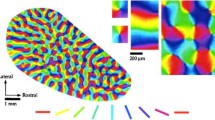Abstract.
A correlation-based learning (CBL) neural network model is proposed, which simulates the emergence of grating cells as well as some of their response characteristics to periodic pattern stimuli. These cells, found in areas V1 and V2 of the visual cortex of monkeys, respond vigorously and exclusively to bar gratings of a preferred orientation and periodicity. Their non-linear behaviour differentiates grating cells from other orientation-selective cells, which show linear spatial frequency filtering.
Similar content being viewed by others
Author information
Authors and Affiliations
Additional information
Received: 9 June 1997 / Accepted in revised form: 9 February 1998
Rights and permissions
About this article
Cite this article
Brunner, K., Kussinger, M., Stetter, M. et al. A neural network model for the emergence of grating cells. Biol Cybern 78, 389–397 (1998). https://doi.org/10.1007/s004220050443
Issue Date:
DOI: https://doi.org/10.1007/s004220050443




